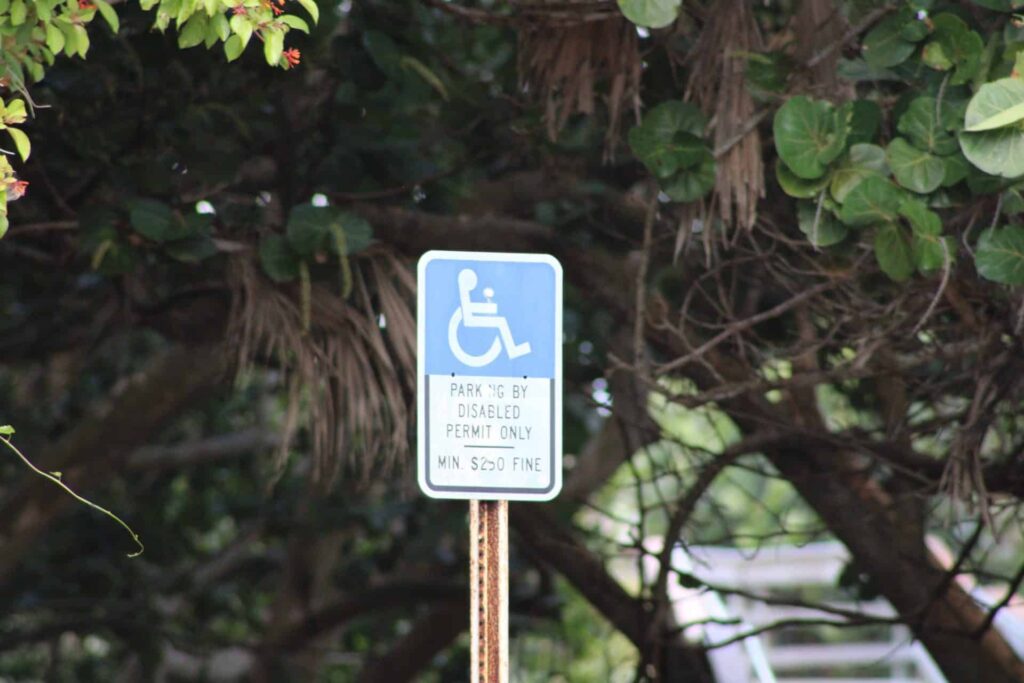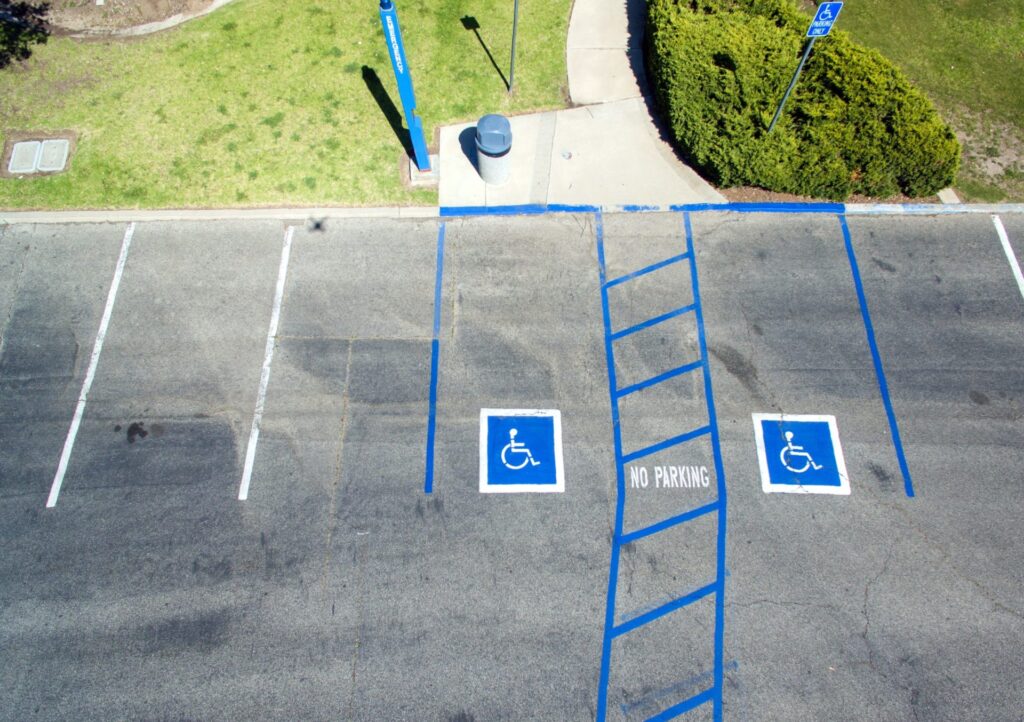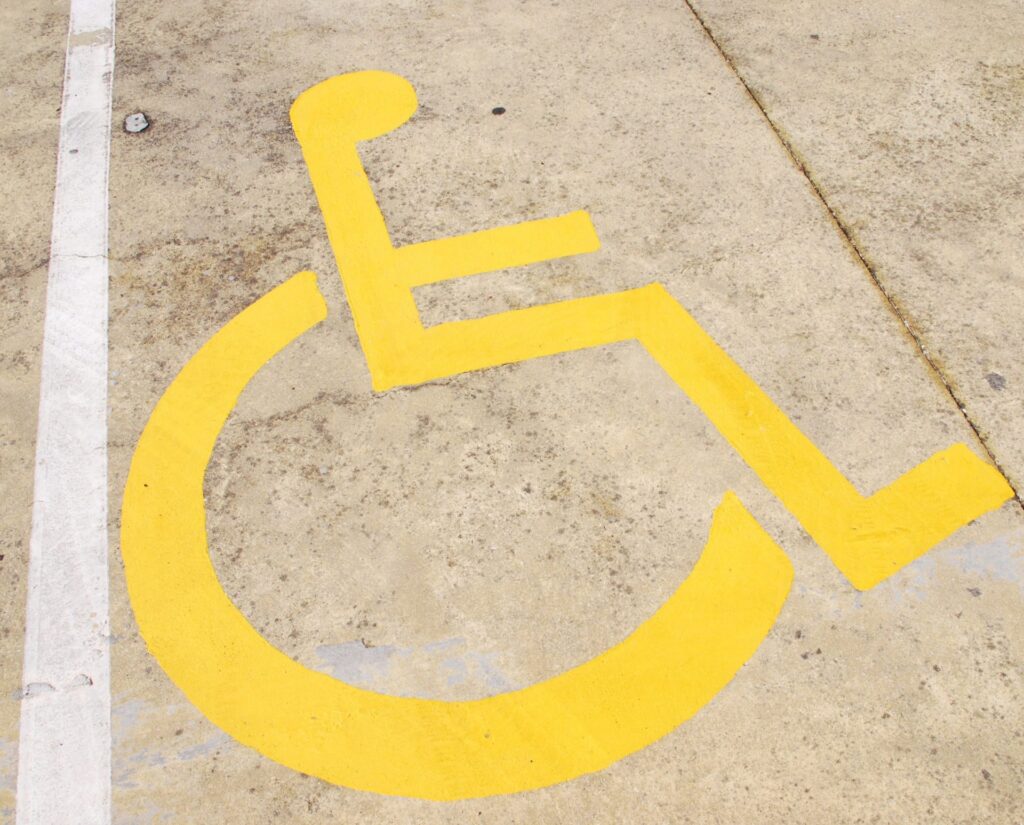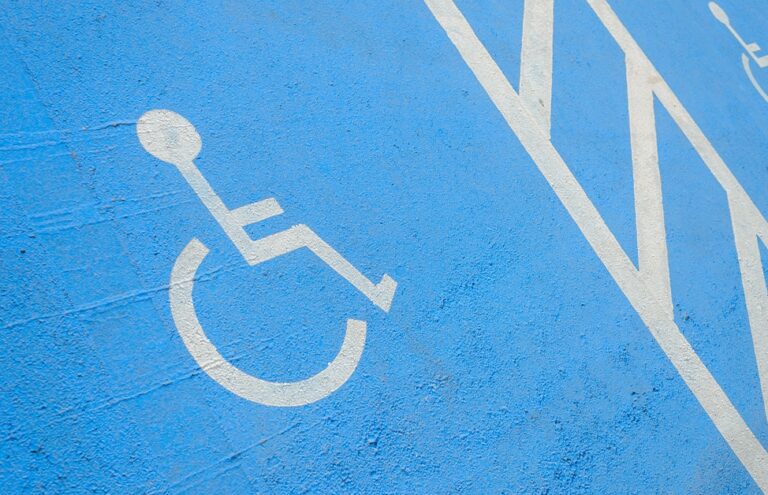Accessible parking is important to many Americans: 26% of adults in the United States live with a disability. Almost 14% of those adults have a mobility disability with serious difficulty walking or climbing stairs, and nearly 7% of the adults with an independent living disability have difficulty doing errands alone.
Those with a mobility-limiting disability that may make walking painful or difficult could be qualified for a parking permit. With a handicap parking permit, handicap parking spaces near the entrances of buildings are readily available to help the individuals who need the shortest accessible route to save time and energy.
Handicap Parking Requirements: What Qualifies as a Disability?

Disability qualifications are determined under the Americans with Disabilities Act (ADA). Condition requirements must be verified by a state-licensed medical professional. The application process varies by state, but common condition requirements include:
- Restrictions by lung disease;
- Severe heart conditions;
- Portable oxygen requirements;
- The inability to walk extended distances without stopping to rest;
- A severe disability in which there is a need for an assistive device or person for mobility;
- Documented vision impairments;
- Loss or limited use of one or both legs, and/or both hands.
Other conditions may apply, depending on state eligibility guidelines. Common conditions covered by state (but not federal) regulations include: temporary disability as a result from major surgery, pregnancy with complications, and elderly status.
How to Get a Handicap Parking Permit/Placard
There are several steps to obtaining an accessible parking permit or parking placard, and the process generally takes some time. If a disability is easily discernible or visible, the requirement of a physician’s certification may be waived in some states. The steps to getting an accessibility parking permit generally include:
- Check for eligibility with a local Department of Motor Vehicles (DMV).
- Become aware of the options available.
- Time and terms for permits may vary per state. Some states offer license plates with permanent accessibility symbols that may be used in place of a placard or accessibility sticker.
- Obtain an accessibility parking application from the DMV office. In some states, this may be done online.
- Each state has its own forms criteria for parking permits. Typically, the program is run by the state’s DMV.
- Complete and sign the applicant section of the form.
- A health care provider will need to complete and sign the portion of the form that certifies disability.
- The DMV will need verification of any medical conditions by a state- certified healthcare professional such as an optometrist, physician’s assistant, licensed physician, or nurse practitioner.
- Submit the application online, by mail, or in person, and pay any necessary fees.
- For disabled veterans with service-related disabilities, fees may sometimes be waived.
- In most states, the applicant must apply for the permit themselves. Some states allow for an individual to apply on the applicant’s behalf.
- Permits, placards, and accessibility specific license plates must be renewed.
- Renewal and expiration dates, processes, and costs vary by state.
- Some permits may renew automatically. Some permits need resubmittal of applications.
Others may require recertification by a medical professional.
Handicap Parking Permit/Placard Cost
The costs associated with accessibility parking permits and placards depend on the state. The typical fees range from $0.00 to $20.00, but costs may vary. Many states provide free parking to individuals with disabilities by waiving parking fees — sometimes even in state-owned parking garages. It is important to note that many states require metered or parking garage waivers for free parking. You can obtain these waivers through an application and registration process with the state or local DMV. These state- and local-issued waivers are applicable only in certain areas. Private parking facilities and garages may be exempt from free parking, even with a waiver.
Some cities and states will provide you with an accessible spot in a residential area, if needed and applied for. Provided by the local disability commission or DMV, the handicap parking space may be open to use for anyone with a permit, while others can be reserved for use by a specific individual.
Types of Handicap Permits, Placards, and License Plates
There are multiple types of accessibility permits, placards, and even permanent license plates. Placards and permits may also come in a variety of colors designating specific parking conditions available to permit-holders. The following are the most common colors and associated rights and designations:
- Red placards are for people with temporary disabilities, and temporary permits. These are typically issued with a temporary time frame — typically six months — but may be renewed if needed.
- Dark blue placards are for those with permanent disabilities. Though these permits indicate a permanent disability, they may still be subject to renewal periods. The renewal period varies by state.
- Light blue placards are for “wheelchair users only” specific parking spaces. The renewal period varies by state.
Who Can Use My Handicap Placard?
An accessibility permit or placard is issued to you and may be used in any motor vehicle you are employing for transit. This means that you, the permit-holder, may use it as a driver or a passenger. As long as you are a passenger in the car, it does not matter who is actively driving, or who owns the vehicle.
It is important to note that you must be present when the placard is displayed. Letting others “borrow” a placard, even if it is for a service such as running an errand on your behalf, is a misuse of the placard. Misuse of a placard can lead to cancellation of a permit, fines for both yourself and the one “borrowing” or using it, community service, as well as other potential penalties.
Handicap Parking Rules: Can I Park Anywhere With a Handicap Placard?

Accessibility permits allow for parking in designated spaces that have been identified with specifically colored striping and signage. Some parking may be available in public spaces, such as metered parking, outpatient physical therapy facilities or a garage parking, but these opportunities may be limited by the facility. Many cities and states offer free parking to accessibility permit- holders with a DMV-issued waiver.
The accessibility permit does not allow for parking in any zone which state law or ordinance has set aside or reserved for specific types of vehicles, such as emergency or business operation vehicles, including street vending vehicles. Spaces that prohibit stopping or parking any or all vehicles (even an electric vehicle) are also not available to accessible parking permit holders. Parking in the loading and unloading area of a handicapped parking space that is already occupied by a vehicle is also prohibited; this area is designated by yellow crosshatch striping.
What Do I Do About a Handicap Permit When I Travel?
Many states offer reciprocity for accessibility permits, but some do not. It is important to check with the local DMV that provided the permit. In many cases, traveling with an accessibility license plate across state borders is acceptable, as the plate is permanently attached to the vehicle and is a part of the vehicle’s registration.
Traveling across state borders with an accessibility placard is generally acceptable, but some states do require an additional traveler’s permit. It is important to check with the local DMV of the intended destination. An accessibility placard should include the International Symbol of Access (the image of a person in a wheelchair) and the symbol must be at least three inches in height. The symbol should be white on a blue background (unless temporary or otherwise designated). The disability placard should have an identification number, a date of expiration, as well as a seal or identification mark from an issuing authority.
If you’re traveling outside of the U.S., each country has its own standards of accessibility for persons with disabilities. It is a good practice to extensively research the destination country and any specific laws that might pertain to you. It is also important to check with the U.S. Department of State’s Bureau of Consular Affairs to ensure that all international driving permits are met, and that you understand all driving laws so that you can drive abroad safely.
What Do I Do if My Handicap Parking Placard Is Lost or Stolen?
The loss of an accessibility permit can create difficulties, so it is best to resolve the issue as quickly as possible. Fortunately, the replacement process is much simpler than the application process in many states. It is important to meet the local DMV requirements during the replacement process, as applications may vary by state.
Important information to know about replacing a parking placard:
- Most states do not require a payment for a replacement; if they do, the fee is typically nominal; $10 or less.
- A visit to a doctor should not be necessary.
- If a placard is damaged, the DMV often requests that the damaged placard be surrendered and replaced.
- If a placard is believed to be stolen, many states request or require a police report to be filed. It is good practice to contact the local DMV, which will provide the necessary information.
- A replacement placard typically takes four weeks to arrive after the submittal of a replacement application, though times may vary depending on the status of the local DMV.
Steps to replace an accessibility placard:
- Contact the local DMV to request an application for a replacement accessibility permit. If you think placard was stolen, ask the local DMV if a police report needs to be filed.
- The placard replacement application may ask for the following:
- Personal contact info, including full name, mailing address, and birthdate.
- Your driver’s license number. The individual’s driver’s license number.
- The individual’s vehicle ID number (VIN).
- The permit or placard’s identification number.
- The official document or type of permit that is being requested.
- The reason behind the replacement; i.e. if the disabled placard is considered lost, stolen, not received, or damaged.
- The placard replacement application may ask for the following:
- Make a copy of the validated receipt for the original placard to submit with the renewal application.
- If you can’t find the original receipt, complete a new Physician’s Statement for Disabled Persons Placard form (as per state) to submit with the application.
- Submit all required information by mail, in person, or online to the local state DMV.
How Long Does It Take to Get a Temporary Placard?
A replacement placard typically takes four weeks from the submittal of a replacement application, though it may take as little as two weeks, or longer. Times vary depending on the processing status of the local DMV.
What Do I Do If I Can’t Find a Handicap Spot?

If no accessible or disabled parking spaces are available, the first step is to ensure that all vehicles parked in accessible spots have the correct accessibility license plates or placards. If a vehicle is illegally parked in an accessibility space, it should be reported. Call or contact the store or facility; they may help you find alternative options for parking.
If the issue is residential — you cannot find accessible parking at your place of residence — reach out to the housing provider with accommodation needs. If the housing provider refuses, you may request a reasonable accommodation or a reasonable modification to make your home more accessible. The FHA ensures your needs are met by making it illegal for the housing provider to refuse the request. Though a request may be submitted verbally, it is best to provide a request in writing so that you’ll have a record of the interaction in case a complaint must be filed.
How Do I Report Cars Parked Illegally in a Handicap Spot?
Reporting a car illegally parked in an accessible parking space requires a few steps.
- Gather important information. Check to make sure that the car in the accessible parking space does in fact not have the proper placard or plates. Check to make sure that the individual entering or exiting the car is not a person with a disability. It is important to note that not all instances of disability are visible. If the car is parked illegally, copy down the license plate number as well as the accessibility placard number (if there is one).
- Report the violation to the non-emergency line of the local police department.
- All police departments maintain a non-emergency phone line. This is the appropriate and proper way to report any crime that is not actively occurring or threatening to persons or property.
- Visiting a local police department is another way to submit a report. Visiting a police department allows for the presentation of physical evidence as well as providing a statement that includes details.
- File an online report. Some municipalities and sheriff’s departments maintain an online reporting system.
- Submit an accessibility parking complaint to the organization HandicappedFraud.org. This organization catalogs reports, and submits them to the proper state authorities.
Fines and punishments for parking illegally in accessible spaces vary by state and county. For example, fines in the state of California for the misuse of accessible spaces, placards, or plates range from $200 to $1,000. Punishment may also include a misdemeanor offense that may include up to six months of county jail time.
Is There Handicap Parking Etiquette?

While accessibility parking laws vary between states, there are nationally recognized etiquette standards. Accessible parking etiquette may include:
- Being aware of the types of accessible parking. While there may not be laws specifically associated with which parking spaces (e.g. one-sided-entry wheelchair and two-sided entry wheelchair van accessible spaces for standard accessibility parking spaces) are designated to specific accessibility permits, you should try and use the space most appropriate for your individual needs.
- Appropriately display the permit or placard. State regulations may differ, but in general, it is important to display the permit or placard in a clearly visible location. If the permit or placard is designed to be hung, it should be hung from the rearview mirror. If it isn’t meant to be hung, the placard or permit should be placed face-up on the dashboard, to the left of the steering wheel.
- Do not use an expired permit or placard.
- Do not “lend” the permit or placard. An accessible parking permit or placard is meant for the transportation of the individual it is assigned to. It is illegal for both the “lender” and “borrower” of the permit or placard to misuse it, and both parties may be fined accordingly. This includes lending a placard for someone to use while they’re running an errand for an individual with a disability. A permit or placard can even be revoked for misuse.
- Keep access aisles completely open. Never park in a cross-hatched access aisle. These aisles are meant for wheelchair access.
- Not all disabilities are visible; be aware of judging those who may not look disabled. Different states issue permits for different reasons; just because a person may not seem visibly disabled doesn’t mean they don’t need the accessibility space.
How Can My City Improve Handicap Parking?
The effort of improving accessible parking is shared by the public, permit holders, city zoning, and private facilities. The public and permit holders may help the city by holding people accountable for the misuse of accessible parking passes and placards, as well as by reporting any misuse of accessible parking spaces. Cities may also improve accessible parking by ensuring that all requirements of the Americans with Disabilities Act are met, and that all new constructions and alterations of existing facilities proceed accordingly.
Innovative technologies such as Parking Access Revenue Control Systems (PARCS) are systems on the internet of things that can be run, and monitored, with immediate information updates to the cloud. With the ability to keep pace with developing cities, a parking system or a full suite of parking solutions with mobility in mind, and support for infrastructure of all types, technology has the opportunity to change the accessibility of parking and transportation worldwide.
Other Frequently Asked Handicap Parking Questions
- Is it difficult to get an accessible parking permit? It is not difficult to get a parking permit, but it does require time, and the completion of several steps, including a recommendation from a healthcare provider.
- Do I qualify for an accessible parking permit if I don’t use a wheelchair? You do not need to be in a wheelchair or have a visible disability to qualify for accessible parking.
- Are there age restrictions for accessible parking permits? There are no age restrictions for accessibility parking permits.
- Can accessible parking permits be transferred to another car? As long as the individual with a disability is in the car, you can use the accessibility parking permit to park in designated accessible parking spaces. If the individual with a disability is not in the vehicle, the permit cannot be transferred or “shared.”
- What is the crosshatch next to the accessibility parking space? The crosshatch section is to ensure that people have enough space to get in and out of the car, particularly if they are using a wheelchair.
- Are accessible spaces only available at certain times of day? Spaces that are designated for accessible parking are available at all times.
- Is an accessible parking permit valid out of state? Many states offer reciprocity, though not all. It is important to check with the DMV of the state that issued the permit, as well as the state of intended travel.
- Are parking lot garages and street parking free to people with accessibility permits and placards? Laws for available or free parking depend on the location and facility. Some cities and states offer free parking for those that register through a program or file for a waiver. It is important to discuss this with a local DMV before parking in metered or regulated garages without paying.
- Can a person park in an access-specific space if they are picking someone up who has a valid accessibility parking permit or placard? Yes. Though the placard or permit is issued to an individual, the designation is for the vehicle of transit.
Handicap Parking Resources by State
Each state has individual criteria, qualifications, applications, and reciprocity for accessibility parking permits, placards and license plates.
Alaska Permit Application Form
Arkansas Permit Application Form
California Permit Application Form
Connecticut Permit Application Form
Delaware Permit Application Form
Florida Permit Application Form
Georgia Permit Application Form
Illinois Permit Application Form
Indiana Permit Application Form
Kansas Permit Application Form
Kentucky Permit Application Form
Maryland Permit Application Form
Massachusetts Permit Application Form
Michigan Permit Application Form
Minnesota Permit Application Form
Mississippi Permit Application Form
Missouri Permit Application Form
Nebraska Permit Application Form
New Hampshire Permit Application Form
New Jersey Permit Application Form
New Mexico Permit Application Form
New York Permit Application Form
North Carolina Permit Application Form
North Dakota Permit Application Form
Oklahoma Permit Application Form
Oregon Permit Application Form
Pennsylvania Permit Application Form
Rhode Island Permit Application Form
South Carolina Permit Application Form
South Dakota Permit Application Form
Tennessee Permit Application Form
Vermont Permit Application Form
Virginia Permit Application Form
Washington Permit Application Form
West Virginia Permit Application Form

